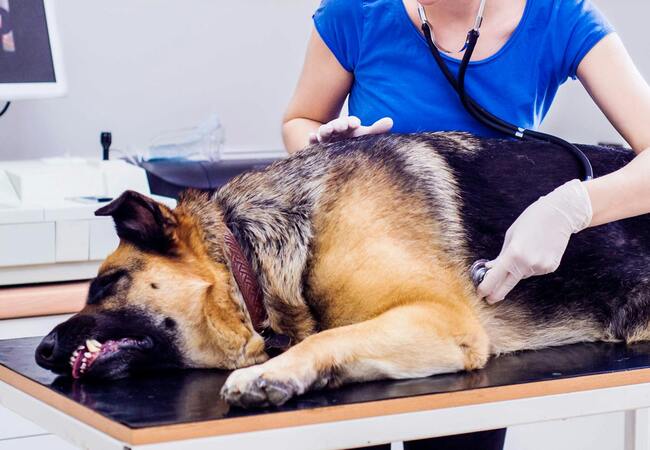Vet’s 2025 Guide to Canine Gastric Stasis Diagnosis, Treatment & Recovery🩺

In this article
Vet’s 2025 Guide to Canine Gastric Stasis Diagnosis, Treatment & Recovery🩺
By Dr. Duncan Houston BVSc
💡 What Is Gastric Stasis?
Gastric stasis (or delayed gastric emptying, gastric hypomotility) occurs when a dog’s stomach empties too slowly, causing food and gas buildup, bloating, abdominal discomfort, nausea, vomiting, even weight loss. It may also overlap with GDV (“bloat”) in severe cases.
🚩 Common Signs to Spot
- Chronic vomiting, especially soon after meals; regurg or belching.
- Painful abdomen, rumbling sounds (borborygmus).
- Loss of appetite, nausea, eating non-food items (pica).
- Bloating, gas, weight loss.
🔍 Why It Happens
Gastric stasis often develops secondary to other issues:
- Metabolic conditions—hypothyroidism, electrolyte imbalances, anemia.
- Gastric disease—gastritis, ulcers, cancer, surgery after-effects.
- Mechanical obstruction—foreign bodies, masses, GDV history.
- Medications or stress/trauma.
🧪 How It’s Diagnosed
- History + physical exam: appetite, vomiting history, abdominal palpation.
- Bloodwork: CBC, chemistry, electrolytes to look for metabolic causes.
- Imaging: X-rays show gas/food retention; contrast (barium) radiographs or ultrasound evaluate motility.
- Advanced diagnostics: endoscopy or biopsies may rule out ulcers or masses.
🩺 Treatment Approaches in 2025
1. Stabilization & Supportive Care
- IV fluids to correct dehydration and electrolytes.
- Pain relief and anti-nausea meds where needed.
2. Dietary Management
- Feed frequent small meals of low-fat, low-fiber diet in liquid/semi-liquid form.
- Warm food may empty faster; carbohydrates tend to pass quicker than high-fat meals.
3. Prokinetic Medications
- **Cisapride:** drug of choice—enhances motility throughout GI tract with fewer side effects.
- Erythromycin (low dose), ranitidine/nizatidine can also promote motility.
- Metoclopramide is less effective peripherally but helps with vomiting.
4. Treat Underlying Causes
- Hypothyroidism, metabolic issues, or infections—all must be addressed.
- Remove obstructions, treat ulcers, or manage after surgery like GDV.
5. Surgery When Needed
- GDV calls for immediate gastropexy and patients at high risk may receive prophylactic tummy tacking (gastropexy).
- Foreign bodies or tumors require surgical removal.
📈 Prognosis & Monitoring
- Good if identified early and treated; chronic or advanced underlying disease carries variable outcomes.
- Recheck via imaging and bloodwork to confirm improvement.
- Long-term use of prokinetics may be needed depending on cause.
🚫 Prevention Strategies
- Prevent large single meals—feed multiple small meals daily.
- Avoid exercise right after eating to reduce bloating risk.
- Promptly treat GI upset or vomiting to prevent stasis.
- Consider prophylactic gastropexy in high-risk deep‑chested breeds.
🏡 Ask A Vet Home Support
- 📅 Track vomiting episodes, bloating, appetite, stool consistency.
- 🕒 Medication and feeding schedule reminders.
- 📸 Upload photos of abdominal distension or vomiting content.
- 🔔 Alerts for signs like severe bloating, labored breathing, or pain.
- 📚 Tutorials: low-fat feeding, hydration support, gentle abdominal massage.
🔍 Key Takeaways
- Gastric stasis is delayed emptying—seen as vomiting, bloating, and discomfort.
- Diagnosis by exam, bloodwork, and imaging is essential.
- Treatment combines fluids, diet changes, prokinetics, and correction of root causes.
- Prophylactic gastropexy and feeding management help prevent recurrence.
- Ask A Vet app guides owners through monitoring, meds, and vet communication at home.
🩺 Final Word ❤️
In 2025, managing gastric stasis means precise diagnostics, prokinetic therapy, dietary care, and tackling underlying health issues. Blending veterinary expertise with home support through the Ask A Vet app allows owners to follow through confidently, helping dogs recover, eat well, and avoid serious complications. Your pup’s stomach health starts with informed, proactive care. 🐾✨
Visit AskAVet.com and download the Ask A Vet app to log signs, schedule medications and diets, upload updates, and stay connected with your vet—right at home. 📲






